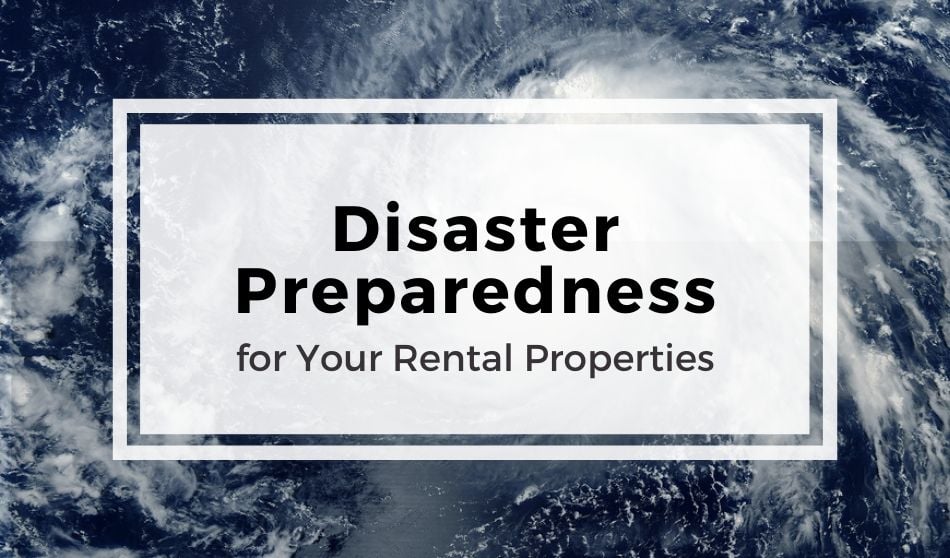
This Disaster Preparedness article first published on June 24, 2019 has been updated with helpful information in light of the 2020 cororonavirus (Covid-19) pandemic.
While driving cross-country on vacation very unusual weather patterns caught us off-guard: a fluke snowfall in Nevada, early tornado season in the midwest, and a hail storm in the high desert. Although unexpected, the many years of handling the unexpected as a property manager the instinctive reaction was calm and cautious.
Although calm and caution can carry you far in an emergency situation on a vacation, a well thought out disaster preparedness plan is vital to the protection of your property investment and care for the safety and well-being of your residents; not to mention, depending on your local laws, may be required.
Before Disaster Strikes
The key is to expect the unexpected which begins with evaluating the type of properties you maintain and their vulnerabilities. Apartments, mobile home parks, HOA’s and commercial buildings will have different needs during an incident compared to a single dwelling or vacation home.
As earthquakes, landslides, tornadoes, and hurricanes are regionally specific, note what hazards and risks would be most likely in your area.
National emergencies are more difficult to anticipate as we have learned from the Covid-19 pandemic. Again, best to consider the types of properties and the unique needs of the individuals residing there.
Disaster Preparedness Plan
From there, the depth and breadth of the disaster preparedness plan is in your hands, but it is advised to check with your insurance provider and other outside agencies to ensure your plan is complete and compliant with any policies, rules and/or regulations.
Ask their advice for other types of emergencies and contingencies to add to your plan such as: wild animal encounters, power outages, national crisis, terrorism or home invasion, resident created events, and/or property related incidents.
If you don’t already have monthly and yearly property rental safety checklists, now would be a good time to create them.
Some areas and items to consider for your checklists could include: falling and tripping hazards, fire extinguisher fill dates, alarm and equipment checks, updated contact numbers, etc.
Remember to include your office in your evaluations (even if you work from home) as your safety is important.
Your disaster plan should include instructions on following the recommendations and guidelines of the local and national governments and agencies in charge.
Create Two Versions: Office and Tenant
Now that you are ready to design and or update your plan, you will want to create two specific versions. A tabbed section binder is useful for office use whereas the tenant version might be designed as a separate handout or included in the welcome packet along with the rules and regulations.
It’s advisable to have both available electronically and saved within cloud storage for online/offline access.
Common section ideas for the tenant version to consider:
- Contact list for local agencies (including a point of contact for the property)
- Exit plans and diagrams
- Call and check-in plans
- Health, safety, and security tips and local resources
- Pet Safety
- Environmental, mechanical, utility, and plumbing issues
Additional items to add to the office procedure document might include:
- Maintenance checklists
- Fire Extinguisher locations
- Breaker and electrical panel locations
- Contractor contact list by service type
- Emergency Agency Telephone Numbers
- Location and instructions to shut off water, gas, and electricity
Important Disaster Plan Considerations:
- Have all emergency exits and fire-safe stairwells clearly marketed; diagrams and maps are imperative.
- Use a routine maintenance check (at least yearly) on smoke, fire, and CO2 detectors, as well as all fire extinguishers. Make sure they are strategically placed, clearly visible, with clear and easy-to-read instructions.
- Many neighborhood watch programs in community settings such as an HOA, apartment complex, or mobile home park include safety and crisis teams. Those leaders can prove to be an invaluable asset.
- Know the safe spots on the property and/or within the community and have those designations well documented.
- Plan for the different types of special needs of your tenants as some may need additional assistance and support.
- If you allow pets on the property, there are many associations and tools to support those four-legged family members. Consider offering pets stickers to identify homes with pets. You can also offer contact information for the American Society for the Prevention of Cruelty to Animals (ASPCA), American Humane Association, Red Rover, and National Animal Poison Control Center.
Steps to Take in an Emergency
Communicate: Although there may not be much time, make time to communicate. Find a good property management software that has built-in text messaging and emailing blast capabilities. Have templates in place so that it only takes a moment to get the word out.
Social media is a great way to get your message out to your residents. posts. In times of emergency people often reach to social feeds for updates. Finding ways to communicate on different platforms helps get updates to the most amount of residents possible while providing a safe and reassuring place for engagement during troubling times.
Lastly, consider creating a calling chain or door-to-door campaign to disseminate information. Advanced planning regarding communication can save not only your investment but potentially lives as well.
Listen: Keep informed by listening to national agencies such as the NOAA (National Oceanic and Atmospheric Administration), FEMA (Federal Emergency Management Agency), The Center for Disease Control (CDC), and other regionally and nationally directed agencies.
Use short-wave and traditional radio stations, social media, or whatever sources are available during the event. Being informed gives you the resources and information needed to follow the recommendations and directives set out by the governing agencies.
In addition to being well informed on the situation, listening to the residents and local community support is paramount.
Finally, listen to your instincts.
You’ve planned, you’re prepared, just remember to breathe.
The Recovery Phase and Beyond
Property Damage
Typically agencies such as The Red Cross or FEMA will inform you when it’s safe to reenter a property. Do not attempt to go into or near a building that has been compromised without the go-ahead from an agency or your insurance company. Safety comes first.
Once cleared to enter, your insurance carrier will work with you on what needs to be restored and repaired. Having good relationships with reliable contractors ahead of time is useful but again, take the advice of your insurance carrier during this process. Keep clear communication with your residents along the way.
After any Emergency
Once the dust has settled, an emergency has been declared over, and life is finding its routine — be sure to schedule a time to maintain code compliance, continue with meeting and communicating with your tenants, and updating the tenant, employee, and disaster preparedness handbook and binders as needed.
Final Thoughts
Statistics confirm that being under-prepared can have severe consequences in terms of property damage or harm to those tenants we aim to serve. To avoid or diminish those risks, partner with your local services, networking groups, and agencies and take advantage of the many resources available (see below).
Of course, keeping a clear mind and calm demeanor day-to-day will serve you well during an emergency event whether you are on vacation or caring for your property portfolio.
Helpful Resources
FEMA offers many programs from information useful for your residents, to training and volunteer programs such as the Community Emergency Response Team (CERT) geared to prepare you for hazards and catastrophes. These resources and training courses are free and offered by FEMA at ready.gov.
Other useful websites:
- The Center for Disease Control (CDC): cdc.gov
- Hurricane Territories: nhc.noaa.gov
- Weather storms, watches, and warning map: weather.gov
- Not only does The Red Cross offer training classes in first-aid and CPR, but they also offer multiple free mobile apps and/or text messaging alerts.






Excellent advice Heather. With all the wild fires in the Pacific Northwest (and throughout the country), we’ve had to up our diaster planning and communication with tenants so we can be as prepared as possible to deal with a devasting fire. Before fire season starts, during a routine inspection/check in, I think it’s a good idea for us to check in with our tenants and provide them a list of emergency services, emergency contacts, and procedures to follow just in case a fire comes to through town. I also love you too to keep templates ready in your email or property management software so it’s one less thing to do if you ever need to send out information to tenants during an emergency.
if a tenant does not comply with corona virus safety tips, can they be quarantined to their room ?
I can understand your concern, John. If you feel like your tenant is breaking temporary laws or putting the health and safety of other tenants at risk, the best thing to do is contact your local law enforcement agency to discuss. My guess is that you probably have a part of your lease agreement stating all tenants must comply with local laws and must refrain from any dangerous activity – any violation of those lease terms would justify contacting your local law enforcement.